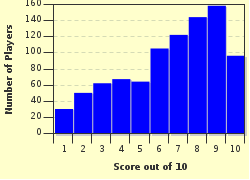Quiz Answer Key and Fun Facts
1. Let's take a 9 volt battery and a 3000 ohm resistor. If we place the two leads of the resistor to the two leads of the battery, how much current will flow?
2. If you were to place a 3000 ohm resistor across a 9 volt battery, what is the power dissipated from this resistor?
3. If you have two 3000 ohm resistors in series, what is our total resistance?
4. If you have two 3000 ohm resistors in series on a 9 volt battery, what is the wattage (power) dissipated from each resistor?
5. If you have two 3000 ohm resistors in parallel, what is the total resistance?
6. If you were to apply two 3000 ohm resistors in parallel across a 9 volt battery, what is the total power dissipated from the battery?
7. If a 3000 ohm resistor and a 1500 ohm resistor and a 10 ohm resistor are placed in parallel, what happens to the total resistance if a 100,000 ohm resistor is added in parallel?
8. What rarely-used electronics equation works for solving TWO and only TWO resistors in parallel?
9. If you have two 3000 ohm resistors in parallel with each other, and a third 3000 ohm resistor in series with the first two, what is the total resistance?
10. If you were to remove the 12 volt battery from your car, and connect a 4.7 k ohm resistor in series with two other resistors in parallel, one of which has a resistance of 3.3 k ohms and the other a resistance of 10 k ohms, what is the current flowing from the battery?
Source: Author
feyd313
This quiz was reviewed by FunTrivia editor
crisw before going online.
Any errors found in FunTrivia content are routinely corrected through our feedback system.

